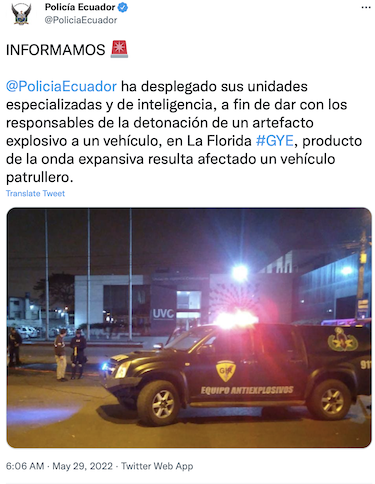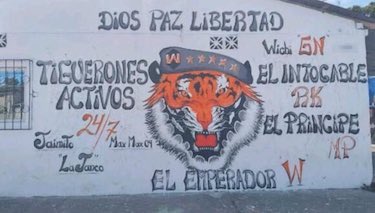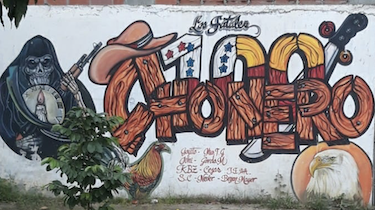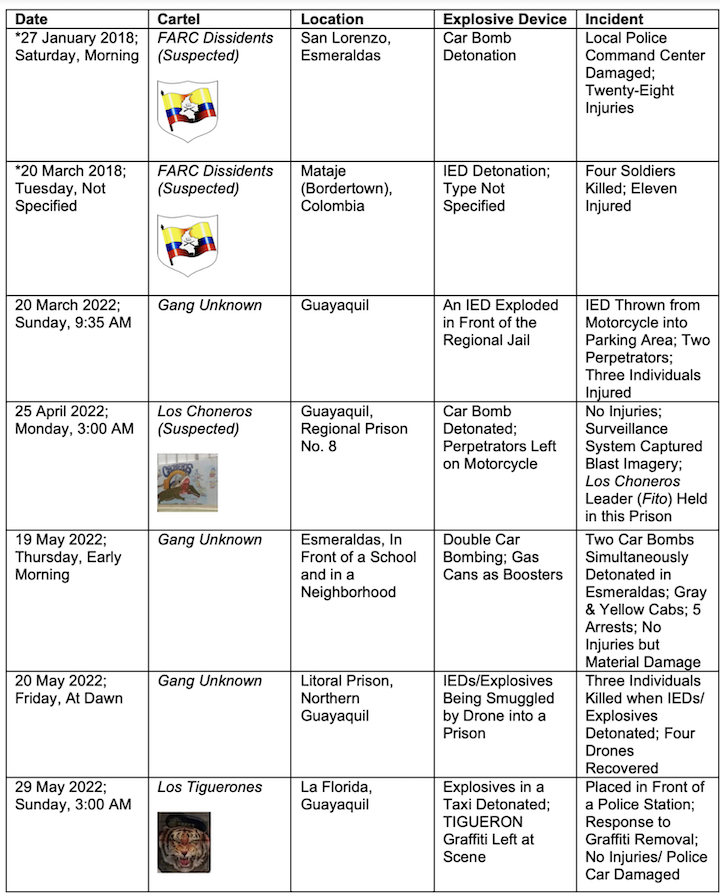Third Generation Gangs Strategic Note No. 50: Criminal Car Bombings, Explosives, Drones, and Organizational Adaptation in Ecuador

Third Generation Gangs Strategic Note No. 50: Criminal Car Bombings, Explosives, Drones, and Organizational Adaptation in Ecuador
John P. Sullivan and Robert J. Bunker
A series of car bombings by criminal gangs in Ecuador demonstrates the challenge of criminal enterprises directly confronting the state. In a recent (29 May 2022) car bombing in front of a police station (Unidad de Vigilancia Comunitaria/Community Surveillance Unit – UVC) in La Florida, Guayaquil, a taxi exploded. The day before, police conducted a controlled removal of an explosive device left in front of a local business. Officials claim the attack was a response to the removal of gang graffiti associated with Los Tiguerones prison gang.
Just over a week prior, police found the remains of three persons suspected of attempting to smuggle explosives by drone into the Litoral Penitentiary (Centro de Rehabilitación Social de Varones N. 1 de Guayaquil) in northern Guayaquil. On 19 May 2022, a double car bombing in the province of Esmeraldas reportedly used gas cans inside the vehicles to amplify the blast. Guayaquil experienced at least five car bombings in May 2022. Both local gangs and Mexican cartels, including the Cártel del Sinaloa (CDS) and Cártel de Jalisco Nueva Generacion (CJNG), are believed to be active in Ecuador’s criminal conflicts.

La Policía Nacional del Ecuador (Policía Ecuador) deployed bomb technicians to the car bombing in front of the La Florida Unidad de Vigilancia Comunitaria (UVC) Police Station. Source: Policía Ecuador @PoliciaEcuador, Twitter. 29 May 2022, https://twitter.com/PoliciaEcuador/status/1530898306821410818?s=20&t=VQbhSD1nf7F2O4qFj4dVVg.
Key Information: “Coche bomba estalla a las afueras de un Cuartel Policial en Guayaquil.” Expresso. 29 May 2022, https://www.expreso.ec/actualidad/coche-bomba-estalla-afueras-cuartel-policial-guayaquil-128397.html:
Un atentado con un coche bomba se registró la madrugada de este domingo 29 de mayo en los exteriores de la Unidad de Vigilancia Comunitaria (UVC) de la ciudadela La Florida, en el norte de Guayaquil.
Aproximadamente a las 03:00, criminales habrían llevado al sitio un automóvil, con los colores e insignias de un taxi amarillo, el cual estalló justo al frente a la puerta principal del cuartel policial.Producto de la explosión, un patrullero de la Policía Nacional sufrió daños. También se pudo observar partes amarillas sobre la calzada, que ‘volaron’ a unos 50 metros del sitio del estallido…
…Sobre un vehículo Grand Vitara SZ, que estaba también afuera del cuartel policial, alguien dejó escrita una leyenda: “TIGUERON”.[1]
Key Information: “Estalló vehículo cerca de unidad policial de La Florida, en el norte de Guayaquil.” El Universo. 29 May 2022, https://www.eluniverso.com/noticias/seguridad/estallo-vehiculo-cerca-a-upc-de-la-florida-en-el-norte-de-guayaquil-nota/:
Un vehículo estalló la madrugada de este domingo en las inmediaciones de una unidad de vigilancia comunitaria (UVC) en el norte de Guayaquil.
La situación ocurrió en la ciudadela La Florida y alarmó al vecindario. Videos aficionados captaron el momento en que el auto ardía en una zona de parqueadero. Vecinos dijeron que la explosión fue cerca de las 03:00…
…No hubo heridos ni víctimas mortales, según información preliminar.
La Policía indicó que envió unidades especiales para investigar el hecho y dar con los responsables…
Esta mañana, el carro detonado fue cubierto, mientras que personal limpiaba los restos que se esparcieron por el área…
…Este es el segundo episodio de explosivos que ocurre en menos de 24 horas en Guayaquil. La tarde de ayer, en 9 de Octubre y Antepara, se detectó un artefacto explosivo cerca de un negocio. La policía tuvo que realizar una detonación controlada.[2]
Key Information: “Reportan explosión de un coche bomba en Guayaquil, Ecuador.” teleSURtv.net. 29 May 2022, https://www.telesurtv.net/news/reportan-explosion-coche-bomba-guayaquil-ecuador-20220529-0027.html:
Plataformas informativas precisan que alrededor de cinco coches bombas estallaron en este mes.
Autoridades ecuatorianas reportaron este domingo la explosión de un coche bomba en las afueras de un cuartel de la Policía de la ciudadela La Florida, en el norte de Guayaquil luego de que fuerzas policiales limpiaran grafitis y simbolismos presuntamente de organizaciones criminales.[3]
Key Information: “3 muertos por posible manipulación explosivos y drones cerca cárcel Ecuador.” La Vanguardia. 20 May 2022, https://www.lavanguardia.com/vida/20220520/8282003/3-muertos-posible-manipulacion-explosivos-drones-cerca-carcel-ecuador.html:
Quito, 20 may (EFE).- La Fiscalía General del Estado de Ecuador ha abierto una investigación para determinar las circunstancias de la muerte esta madrugada de tres individuos que supuestamente manipulaban explosivos y drones cerca de una cárcel de Guayaquil, ciudad de la costa sur del país.
En un mensaje en redes, el órgano fiscal informó este viernes del inicio de la investigación “por la muerte de tres personas que -aparentemente- manipulaban explosivos e intentaban ingresarlos a la Penitenciaría del Litoral, en Guayaquil, utilizando drones”.
La Fiscalía aclaró que el suceso se produjo de madrugada, en un cerro de una urbanización privada en la localidad de Daule, a un kilómetro del centro penitenciario, el más poblado del país, situado en la provincia de Guayas, una de las tres que desde abril se encuentra bajo estado excepción por la violencia callejera del crimen organizado…
…El mayor Henry Meneses, jefe de operaciones del distrito de Daule, precisó que miembros de la unidad antiexplosivos (GIR) de la Policía se desplazaron al lugar y a primera hora del día llevaban a cabo labores de control de “aparatos aparentemente explosivos” que en apariencia eran “similares a unos drones”.
Meneses indicó que se encontraron en el lugar tres cuerpos, algunos de los cuales tenían extremidades desmembradas, presumiblemente por la manipulación de los aparatos no tripulados…
…“Se identifican cuatro drones de características agrícolas, es decir, de capacidad alta para transportar carga de un tamaño bastante grande”, aseguró Miño antes de avanzar que una de las líneas de investigación es que los fallecidos hubieran acudido de madrugada a ese lugar descampado para manipular explosivos.[4]
Key Information: Yalilé Loaiza, “Ecuador: explotaron dos coches bomba durante el Estado de Excepción decretado para combatir la inseguridad.” Infobae. 19 May 2022, https://www.infobae.com/america/america-latina/2022/05/19/ecuador-explotaron-dos-coches-bomba-en-medio-del-estado-de-excepcion-decretado-para-combatir-la-inseguridad/:
La madrugada de este jueves, en Esmeraldas, ubicada en la frontera norte del país, dos coches bomba explotaron simultáneamente en dos lugares de la ciudad. La Policía Nacional confirmó que los explosivos usados en los vehículos fueron de alto impacto. El ministro del Interior, Patricio Carrillo, aseguró que hay cinco detenidos relacionados con las detonaciones.
Los vehículos que explotaron eran un auto color gris y un taxi amarillo. El primero detonó en la calle Colón, entre El Oro y Batallón Montúfar, frente al colegio Luis Vargas Torres; el otro explotó en las calles Espejo y Malecón. Hay dos kilómetros de distancia entre ambas locaciones. Las detonaciones sucedieron al mismo tiempo.
El comandante de la Policía Nacional en Esmeraldas, Javier Buitrón, dijo que los causantes de las detonaciones colocaron tanques de gas en los dos vehículos para que, junto con los explosivos de alto impacto, la onda expansiva y la magnitud de la explosión sea mayor: “Hubo tres explosiones en cada vehículo, explotó el material que colocaron, el cilindro de gas y el tanque de combustible”, explicó el comandante. Hasta el momento no se han registrado víctimas de las explosiones, pero sí hay daños materiales.
Pero el crimen no solo incluyó las detonaciones, sino también el secuestro de los conductores de los vehículos. Los hombres fueron maniatados y abandonados en distintos lugares de la urbe. Según Buitrón, los criminales quieren mostrar su poder delictivo a las autoridades y a los ciudadanos: “Este es un mensaje que los delincuentes están dando a la comunidad y a las autoridades. Ellos quieren demostrar su poder de destrucción. Estamos haciendo las indagaciones para dar con los responsables de este atentado”, dijo…
…Incluso cuatro bandas criminales emitieron un comunicado donde aseguran que buscan la paz. Los Lobos, Los Tiguerones, Los Chone Killers y Los Latin Kings aseguran que dieron un “primer paso de pacificación voluntaria a nivel nacional”. Los líderes de estas agrupaciones delictivas dicen que podrían entregar las armas en las prisiones y aseguran que no defienden a ningún cartel internacional del narcotráfico, contradiciendo así a la versión oficial que los vincula con el cartel Jalisco Nueva Generación.[5]
Third Generation Gangs Analysis
Ecuador is facing an accelerating gang crisis where criminal armed groups (CAGs) directly confront the state in prisons and on the streets. This exemplifies criminal insurgency waged by prison-street gang complexes as seen throughout Latin America. While no casualties were sustained in the 29 May 2022 bombing in front of the Unidad de Vigilancia Comunitaria (Community Surveillance Unit – UVC) police station in La Florida, damage was sustained to a police car. A total of five car bombings in Guayaquil were documented in May during a declared state of emergency.[6] In addition, three persons suspected of smuggling explosives via aerial drone into the Litoral prison in northern Guayaquil were killed on 20 May 2022.[7] An earlier correctional facility explosives incident on 20 March left three persons injured.[8] Other notable cases of CAGs (gangs and cartels) using explosives have been seen in Mexico,[9] Brazil,[10] Colombia,[11] and El Salvador.[12]
In April, hundreds of pamphlets threatening to kill Ecuador’s Interior Minister were placed in front of a television station. The pamphlets contained images of the Mexican and Ecuadorian flags, a photo of the Minister, and an image (silhouette) of a tiger, associated with the gangs known as Los Tiguerones (tigers or gangsters).[13] According to Ecuadorian analysts such as Mario Pazmiño, a former director of military intelligence, and Alexandra Mantilla, a lawyer studying Ecuadorian organized crime, local gangs in Ecuador are transitioning into ‘microcarteles’ (micro-cartels).[14] According to Mantilla, the megabandas in transition to a microcartelesorganization are evolving to embrace cartel organizational characteristics, with the Tiguerones emulating the CJNG model and the Choneros (from the city of Chone) adopting the CDS template.[15][16]

Los Tiguerones Graffiti. Ministerio del Interior Ecuador (@MinInteriorEc). Twitter. 29 May 2022, https://twitter.com/MinInteriorEc/status/1530955446391287812.

Choneros Graffiti, Gang Social Media, Facebook. 7 July 2021, https://www.facebook.com/groups/456146145840434/media.
In this typology, the analysts view Ecuadorian criminal evolution as consisting of a spectrum ranging from bandas delectivas (criminal bands or gangs) to ‘megabandas,’ then microcarteles, protomafias, and then mafias.[17] This model is an alternative view to the gang evolution seen in third generation gang (3 Gen Gang) theory.[18]. Within the 3 Gen Gang framework, the bandas delictivas would correspond to first generation gangs, the megabandas to second generation gangs, and the microcarteles to third generation gangs. Third generation gangs are essentially a transitional form where gangs have the potential to become more sophisticated criminal enterprises such as cartels or mafias.[19]
The proliferation of car bombs and explosive devices (along with the use of weaponized drones) is an example of cartel adaptation and technological innovation—See Table 1 for selected incidents. In this case, as local gangs interact with more sophisticated enterprises, the opportunity to embrace new technology, enhance the sophistication of local gangs, and stimulate organizational evolution is demonstrated.[20] Further, concern exists that, as the CJNG and CDS continue their ongoing Latin American hemispheric strategic competition, more countries such as Ecuador—and Colombia which has already experienced significant Mexican cartel penetration—will be increasingly drawn into the broadening criminal insurgencies now evident throughout Latin America.[21] These criminal insurgencies are becoming horizontally interlocked from a geographic perspective. We are also seeing the involvement of different forms of criminal groups—gangs (pandillas or criminal bands), former guerilla groups, vigilantes/armed militias, and cartels—representative of broadening vertical integration from an organizational perspective.

Table 1: Use of Car Bombs/VBIEDs and IEDs by Ecuadoran Gangs (Selected)
*FARC Bombings Historical Baseline
Sources
“3 muertos por posible manipulación explosivos y drones cerca cárcel Ecuador.” La Vanguardia. 20 May 2022, https://www.lavanguardia.com/vida/20220520/8282003/3-muertos-posible-manipulacion-explosivos-drones-cerca-carcel-ecuador.html.
“Coche bomba estalla a las afueras de un Cuartel Policial en Guayaquil.” Expresso. 29 May 2022, https://www.expreso.ec/actualidad/coche-bomba-estalla-afueras-cuartel-policial-guayaquil-128397.html.
“Estalló vehículo cerca de unidad policial de La Florida, en el norte de Guayaquil.” El Universo. 29 May 2022, https://www.eluniverso.com/noticias/seguridad/estallo-vehiculo-cerca-a-upc-de-la-florida-en-el-norte-de-guayaquil-nota/.
Yalilé Loaiza, “Ecuador: explotaron dos coches bomba durante el Estado de Excepción decretado para combatir la inseguridad.” Infobae. 19 May 2022, https://www.infobae.com/america/america-latina/2022/05/19/ecuador-explotaron-dos-coches-bomba-en-medio-del-estado-de-excepcion-decretado-para-combatir-la-inseguridad/.
“Reportan explosión de un coche bomba en Guayaquil, Ecuador.” teleSURtv.net. 29 May 2022, https://www.telesurtv.net/news/reportan-explosion-coche-bomba-guayaquil-ecuador-20220529-0027.html.
Henry Shuldiner, “Car Bombs Send Shock Waves Through Ecuador.” InSight Crime. 6 June 2022, https://insightcrime.org/news/explosions-mark-latest-phase-ecuadors-dissent-into-violence/.
Endnotes
[1] In English, the title reads; “Car bomb explodes outside a Police Station in Guayaquil.” The text reads: “A car bomb attack took place early Sunday morning, May 29, outside the Community Surveillance Unit (UVC) in La Florida, in the north of Guayaquil. At approximately 3:00 a.m., criminals allegedly took to the site a car with the colors and insignia of a yellow cab, which exploded just in front of the main door of the police station, and as a result of the explosion, a National Police patrol car was damaged. Yellow parts, which ‘flew’ about 50 meters from the site of the explosion were also seen on the roadway. […] Someone left a written legend ‘TIGUERON’ [tiger or gangster] on a Grand Vitara SZ vehicle, which was also outside the police station.”
[2] In English, the title reads: “Vehicle exploded near police unit in La Florida, in the north of Guayaquil.” The text reads: “A vehicle exploded early Sunday morning in the vicinity of a community surveillance unit (UVC) in the north of Guayaquil. […] The situation occurred in La Florida neighborhood and alarmed the neighborhood. Amateur videos captured the moment when the car was burning in a parking area. Neighbors said that the explosion was around 03:00. […] There were no injuries or fatalities, according to preliminary information. The police indicated that they sent special units to investigate the incident and find those responsible. This morning, the detonated car was covered, while personnel cleaned the debris that was scattered in the area. […] This is the second episode of explosives that occurred in less than 24 hours in Guayaquil. Yesterday afternoon, at [Boulevard] 9 de Octubre and [Avenida José de] Antepara, an explosive device was detected near a business. The police had to carry out a controlled detonation.”
[3] In English, the title reads: “Car bomb explosion reported in Guayaquil, Ecuador.” The text reads: “Information platforms state that around five car bombs exploded this month. Ecuadorian authorities reported on Sunday the explosion of a car bomb outside a police barracks in La Florida, in the north of Guayaquil, after police forces cleaned graffiti and symbols allegedly belonging to criminal organizations.”
[4] In English, the title reads: “3 dead in possible explosive and drone operation near Ecuador jail.” The text reads: Quito, May 20 (EFE) – Ecuador’s Attorney General’s Office has opened an investigation to determine the circumstances of the deaths early this morning of three individuals who were allegedly handling explosives and drones near a prison in Guayaquil, a city on the country’s southern coast. In a message on networks, the prosecutor’s office informed on Friday of the beginning of the investigation ‘for the death of three people who—apparently—were handling explosives and trying to enter the Penitenciaría del Litoral, in Guayaquil, using drones.’ The Prosecutor’s Office clarified that the event took place at dawn, on a hill of a private urbanization in the town of Daule, one kilometer away from the penitentiary center, the most populated in the country, located in the province of Guayas, one of the three that since April has been under a state of emergency due to street violence by organized crime. […] Major Henry Meneses, head of operations in the district of Daule, said that members of the anti-explosives unit (GIR) of the police went to the place and earlier in the day they were carrying out control work on ‘apparent explosive devices’ which appeared to be similar to drones.’ Meneses indicated that three bodies were found at the site, some of which had dismembered limbs, presumably due to the of the unmanned devices. […] ‘Four agricultural drones have been identified, that is to manipulation say, with a high capacity to transport a fairly large load,’ said Miño before advancing that one of the lines of investigation is that the deceased had gone to this open space at dawn to manipulate explosives.”
[5] In English, the title reads: “Ecuador: two car bombs exploded during the State of Emergency [that was] declared to combat insecurity.” The text reads: “Early Thursday morning, in Esmeraldas, located on the northern border of the country, two car bombs exploded simultaneously in two places in the city. The National Police confirmed that the explosives used in the vehicles were of high impact. The Minister of the Interior, Patricio Carrillo, assured that five people have been arrested in connection with the detonations. The vehicles that exploded were a gray car and a yellow cab. The first detonated on Colon Street, between El Oro and Batallón Montúfar, in front of Luis Vargas Torres school; the other exploded on Espejo and Malecón streets. There are two kilometers of distance between both locations. The detonations occurred at the same time. The commander of the National Police in Esmeraldas, Javier Buitrón, said that those who caused the detonations placed gas tanks in the two vehicles so that, together with the high impact explosives, the shock wave and the magnitude of the explosion would be greater: ‘There were three explosions in each vehicle, the material they placed, the gas cylinder and the fuel tank exploded,’ explained the commander. So far, no victims have been reported from the explosions, but there is material damage. But the crime not only included the detonations, but also the kidnapping of the drivers of the vehicles. The men were tied up and abandoned in different parts of the city. According to Buitron, the criminals want to show their criminal power to the authorities and citizens: ‘This is a message that the criminals are giving to the community and the authorities. They want to demonstrate their destructive power. We are making inquiries to find those responsible for this attack,’ she said. […] Four criminal gangs have even issued a communiqué stating that they are seeking peace. Los Lobos, Los Tiguerones, Los Chone Killers, and Los Latin Kings claim that they have taken a “first step towards voluntary pacification at a national level.” The leaders of these criminal groups say they could hand in their weapons in prisons and assure that they are not defending any international drug trafficking cartel, contradicting the official version that links them to the Jalisco Nueva Generación cartel [CJNG].”
[6] Yalilé Loaiza, “Ecuador: explotaron dos coches bomba durante el Estado de Excepción decretado para combatir la inseguridad [Ecuador: two car bombs exploded during the State of Emergency declared to combat insecurity].” Infobae. 19 May 2022, https://www.infobae.com/america/america-latina/2022/05/19/ecuador-explotaron-dos-coches-bomba-en-medio-del-estado-de-excepcion-decretado-para-combatir-la-inseguridad/.
[7] “3 muertos por posible manipulación explosivos y drones cerca cárcel Ecuador [3 dead in possible explosive and drone operation near Ecuador jail].” La Vanguardia. 20 May 2022, https://www.lavanguardia.com/vida/20220520/8282003/3-muertos-posible-manipulacion-explosivos-drones-cerca-carcel-ecuador.html.
[8] “Artefacto explosivo estalla frente a la cárcel regional de Guayaquil [Explosive device explodes in front of Guayaquil regional jail].” Ecuavisa. 20 March 2022, https://www.ecuavisa.com/noticias/cronicaroja/artefacto-explosivo-estalla-frente-a-la-carcel-regional-de-guayaquil-CX1462884.
[9] On Mexico, for a recent example, see Daniel Weisz Argomedo, Nathan P. Jones, John P. Sullivan, and Robert J. Bunker, “Mexican Cartel Strategic Note No. 33: Pueblos Unidos Launch Sophisticated Prison Break Allegedly Using Coches Bomba (Car Bombs) or IEDs,” Small Wars Journal. 20 December 2021, https://smallwarsjournal.com/index.php/jrnl/art/mexican-cartel-strategic-note-no-33-pueblos-unidos-launch-sophisticated-prison-break.
[10] On Brazil, for a recent example, see John P. Sullivan, José de Arimatéia da Cruz, and Robert J. Bunker, “Third Generation Gangs Strategic Note No. 48: “Novo Cangaço” Style Urban Raid in Guarapuava, Paraná (PR), Brazil.” Small Wars Journal. 9 May 2022, https://smallwarsjournal.com/jrnl/art/third-generation-gangs-strategic-note-no-48-novo-cangaco-style-urban-raid-guarapuava.
[11] On Colombia, see, for example, Robert J. Bunker and John P. Sullivan, “Mexican Cartel Strategic Note No. 28: Alleged Cártel de Jalisco Nueva Generación (CJNG) Car Bombing (“Coche Bomba”) in Colombia.” Small Wars Journal. 5 December 2019, https://smallwarsjournal.com/jrnl/art/mexican-cartel-strategic-note-no-28-alleged-cartel-de-jalisco-nueva-generacion-cjng-car.
[12] On El Salvador, see, for example, John P. Sullivan and Robert J. Bunker, “Third Generation Gangs Strategic Note No. 16: MS-13 Suspected in Car Bombing that Injures Two Policía Nacional Civil (PNC) in Soyapango, El Salvador.” Small Wars Journal. 5 May 2019, https://smallwarsjournal.com/jrnl/art/third-generation-gangs-strategic-note-no-16-ms-13-suspected-car-bombing-injures-two.
[13] “De megabandas a ‘microcarteles’, así está mutando el crimen organizado en Ecuador” [From mega-gangs to ‘micro-cartels’, how organized crime is mutating in Ecuador].” Ecuavisa. 29 April 2022, https://www.ecuavisa.com/lo-nuevo-ecuavisa/de-megabandas-a-microcarteles-asi-esta-mutando-el-crimen-organizado-en-ecuador-DY1661410.
[14] Ibid.
[15] Ibid.
[16] On the Sinaloa template, see Vanda Felbab-Brown, “How the Sinaloa Cartel rules.” Brookings. 4 April 2022, https://www.brookings.edu/opinions/how-the-sinaloa-cartel-rules/; on CJNG, see Vanda Felbab-Brown, “How Mexico’s Cartel Jalisco Nueva Generación rules.” Brookings. 29 May 2022, https://www.brookings.edu/opinions/how-mexicos-cartel-jalisco-nueva-generacion-rules/ and Nathan P. Jones, “The Strategic Implications of the Cártel de Jalisco Nueva Generación.” Journal of Strategic Security. Vol. 11, no. 1, 2018: pp. 19−42, https://digitalcommons.usf.edu/jss/vol11/iss1/3/. On criminal networks in Latin America in general, see InSight Crime, “Criminal Networks in the Americas.” CLAS Working Papers Series, No. 33. Insight Crime and American University’s Center for Latin American & Latino Studies. January 2022, https://es.insightcrime.org/wp-content/uploads/2022/01/Criminal-Networks-in-the-Americas-InSight-Crime.pdf. On the distinction between the Sinaloa and CJNG network structures and their interaction with their respective subgroups, see Nathan P. Jones, Irina Chindea, Daniel Weisz-Argomedo, and John P. Sullivan, “Mexico’s 2021 Dark Network Alliance Structure: An Exploratory Social Network Analysis of Lantia Consultores’ Illicit Network Alliance and Subgroup Data.” Center for the United States and Mexico, Working Paper. Houston: Rice University’s Baker Institute for Public Policy. April 2022, https://doi.org/10.25613/KMGB-NC83.
[17] Op. cit., “De megabandas a ‘microcarteles’” at Note 13.
[18] See, for example, John P. Sullivan and Robert J. Bunker, Eds. Strategic Notes on Third Generation Gangs. (A Small Wars Journal–El Centro Anthology.) Bloomington: Xlibris,2020, https://www.amazon.com/Strategic-Notes-Third-Generation-Gangs/dp/1796095613; John P. Sullivan and Robert J. Bunker, “Third Generation Gang Studies: An Introduction.” Journal of Gang Research. Vol. 14, no. 4, 2007: pp. 1–10, https://scholarship.claremont.edu/cgi/viewcontent.cgi?article=1137&context=cgu_fac_pub.
[19] More research is needed on this transition. See, for example, Robert J. Bunker and John P. Sullivan, “Cartel Evolution: Potentials and Consequences.” Transnational Organized Crime. Vol. 4, no. 2. Summer 1998; pp. 55-74, https://www.academia.edu/3173100/Cartel_Evolution_Potentials_and_Consequences; and Robert J. Bunker and John P. Sullivan, “Cartel evolution revisited: third phase cartel potentials and alternative futures in Mexico.” Small Wars & Insurgencies. Vol. 21, no. 1, 2010: pp. 30–54, https://doi.org/10.1080/09592310903561379.
[20] See Nathan P. Jones, “Bacterial Conjugation as a Framework for the Homogenization of Tactics in Mexican Organized Crime.” Studies in Conflict & Terrorism. Vol. 4, no. 10, 2021: pp. 855–884, https://doi.org/10.1080/1057610X.2019.1586356.
[21] In recognition of the threat the Government of Ecuador is in the process of modernizing its military and police forces to address the threat of transnational organized crime. See Julieta Pelcastre, “Ecuador Increases International Cooperation to Combat Narcotrafficking.” Diálogo Americas. 16 June 2022, https://dialogo-americas.com/articles/ecuador-increases-international-cooperation-to-combat-narcotrafficking/#.Yq02Wi-B2X0.
For Additional Reading
Henry Shuldiner, “Car Bombs Send Shock Waves Through Ecuador.” InSight Crime. 6 June 2022.
Robert J. Bunker, John P. Sullivan, David A. Kuhn, and Alma Keshavarz, “Use of IEDs and VBIEDs in Mexican Crime Wars.” Counter IED-Report. Spring-Summer 2021. pp. 63–73.
John P. Sullivan and Robert J. Bunker, Eds. Strategic Notes on Third Generation Gangs. (A Small Wars Journal–El Centro Anthology.) Bloomington: Xlibris, 2020.
John P. Sullivan and Robert Bunker, “Cartel Car Bombings in Mexico.” Letort Paper. Carlisle Barracks. US Army War College, Strategic Studies Institute. 2013: pp. 1–53.






